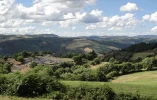I agree with
@dick bird (and to some extent with the rest). I saw a lot of good info on the forum before I walked but pretty much everyone used the same guidebook and/or read the same posts. By googling I learned a lot more about the area. I read a book designed just for tourists in the area of the Norte and Primitivo, and one for Spain in general. Those gave me a lot of places to look for that are usually listed as day trips for tourists in the major cities. Because I wanted to stay in monasteries when possible I read a book on that. I wanted to avoid fiestas as much as possible so I looked up festival dates—for those wanting to see festivals the same method applies just the reverse goal. I planned a rest day in Lugo and had a long list of things to see. Ditto Oviedo. Not because I needed rest but because you can’t just walk past those cities. If you must just rush through one make it Lugo. You really want a day to see Oviedo. I walked longer than average stages because I could, but that’s a way to make up time spent in Oviedo and Lugo if time is tight. do the hospitales route.
The Primitivo was my favorite—I hope it’s everything you could want.
Buen Camino
edit: if possible with covid and your walking plans, stay at Bodenaya.




















